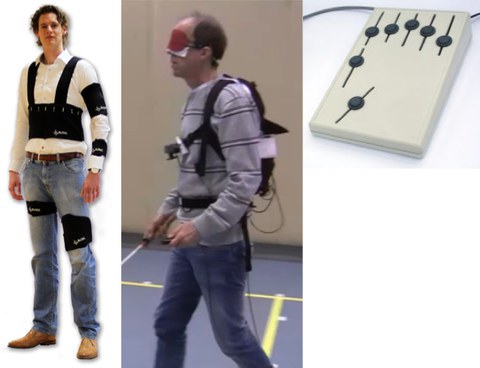Accessibility / In-House-Navigation / Warnings & Communication
(Prof. Weber, Prof. Marquardt, JProf. Krzywinski, Cognitec, exelonix, Linguwerk, Interactive Minds, T-Systems MMS)
| Registration to visit the demonstartors |
| Online Registration |
Elderly people, chronically ill people, and people with a disability experience in everyday situations more and more sensory, physical or cognitive barriers. Both public and private spaces have to be adapted to become accessible on an individual basis. People affected from Alzheimer-disease or other kind of dementia often suffer from cognitive limitations, from displaying behavioural problems or psychosocial restrictions, including degeneration or limitations of their ability for memorization and perception.
Visitors of this trail experience the need for accessibility by simulating needs for assistive technologies in an individual tour through the simulation lab of the Chair for Social and Health Care Buildings and Design as well as inclusive teaching facilities at TU Dresden (EU-projectMOOCAP2014-2017) including virtual story telling.
Furthermore visitors of this trail will encounter mindful design(MIND-project 2016-2019) for medical treatment and nursing of people with dementia and how it affects psychosocial well-being of people with dementia as well as models and demonstrators from research projects towards architecture for demographic changes such as MATI - Human-Architecture-Technology-Interaction(2014-2016) in emergency hospitals sensitized for dementia.

Haptic Bodywear (left) System for obstacle warnings (middle) Demonstrator of a phone for deafblind people (right)
Accessible navigation for pedestrians in public buildings is demonstrated by a system implemented at TUD for guidance and orientation and is based on annotations together with mobile location-based devices (such as in projectMobility, 2011-2013). In-House-Navigation in a dynamic context utilizes speech input and speech output (Google Now, Apple Siri, Amazon Alexa, Microsoft Cortana) instead of keyboard or touch as well as avoids displays through Haptic Bodywear (cf. Fig.). "Things" in „Smart Co-Care“ become virtually tangible in the Living Lab for their operation and for communication through them when living, nursing or caregiving. Trail-visitors experience a wearable system generating warnings about obstacles in front of blind people (depth camera, bone-conductive headphones and a tactile belt with vibrating actuators) in order to increase their mobility and to extend the range of a long white cane from 1.5m to 7m (cf. Fig., project Range-IT, 2013-2015).
Trail-visitors also will encounter the concept of a novel phone for the deaf blind as developed in project Hapticom(2011-2012). This innovative device enables deafblind people to communicate in realtime alone by their hand’s haptic sense. A software helps to communicate also with other people (such as relatives, authorities and doctors) in a accessible way. Social participation of deaf-blind people is increased considerably and quality of life is improved.
| Registration to visit the demonstartors |
| Online Registration |
